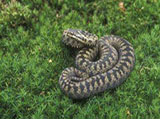
MENDIP ADDER SPECIES ACTION PLAN
Action plan name
Mendip Adder
Background and vision
Adders are the only native venomous snake and because of this have historically been persecuted, although they are now legally protected against killing. While most people appreciate and respect Adders, there is evidence that deliberate persecution persists despite the hard evidence from medical and veterinary records that there are incredibly few records of Adders biting people and even fewer records of deaths or serious injuries.
Vipers give birth to live young. They hibernate underground in communal chambers called hibernacula. Subsequent generations appear to be faithful to the same hibernacula over very long periods of time. Adders tend to be rather localized in their distribution due to their reliance on particular hibernacula, but can migrate quite long distances between hibernation areas and feeding areas.
Emerging from hibernation before the females, male adders remain close to the hibernaculum; they do not feed, instead, they bask to absorb sufficient energy from the sun to slough their old skins and ripen their sperm. Females emerge slightly later and also bask in the vicinity of the hibernaculum without feeding.
Once they have sloughed their old skins they then mate. Males and any nonbreeding females then move off to feeding grounds but mated females remain without feeding until their young are born in August. Their main prey are ground nesting birds, small mammals and amphibians and reptiles (including their own young!)
Adders are particularly vulnerable to loss of hibernacula and unfavourable management and recreational activities in their basking areas close to hibernacula. This is because of their faithfulness to hibernation sites and the fact that both sexes, but particularly females, spend much time in the vicinity or these hibernation sites.
It is very difficult to establish and monitor population levels, but the evidence is that they have decreased in range and numbers considerably over the past fifty years. In Somerset they are still found in large numbers over heathland on Exmoor. On the Quantocks the populations appear particularly fragmented and low in numbers but here on the hills in Mendip District there are important but apparently rather localised populations.
The factors associated with their decline are habitat loss and fragmentation, the adverse impact of increasing numbers of recreational visitors, including deliberate persecution. Management, particularly by burning, can lead to the loss of vegetation cover for basking adders.
Where snakes do not hibernate or where suitable hibernation sites are freely available, population numbers are dictated by availability of prey. It is likely in Somerset, however, that the lack of undisturbed hibernacula in proximity to basking sites is more of a limiting factor.
Plan species and habitats
For hibernacula and basking
· Lowland heathland and associated scrub and bracken
· Open woodland
For feeding areas
· Woodland
· Heathland
· Purple Moor Grass and Rush Pasture
· Other wetland areas rich in amphibians
Prey species
· Small mammals
· ground nesting birds
· other reptiles and amphibians
Species status
Legally protected
Specific impacts/threats
· Habitat fragmentation - including conversion of heathland to forestry
· Direct human impacts – e.g. deliberate and accidental killing and disturbance from dogs and humans while basking. (Nb there is strong evidence from other counties that where interpretation draws attention to presence of adders at a site it leads to a reduction in numbers)
· Warm winters - causing early emergence from hibernation- subsequent cold spells can cause death.
· Fire – heathland management by burning leading to loss of shelter near hibernacula or possible death if adders emerge from hibernation in winter.
Accidental or malicious burning causing death or loss of suitable habitat structure
Proposed partners
Mendip District Council (MDC)
Mendip AONB Rangers (MAONB)
Somerset Environmental Records Centre (SERC)
The National Trust (NT)
The Forestry Commission (FC)
Somerset Wildlife Trust (SWT)
Reptile and Amphibian Group for Somerset (RAGS)
Herpetofauna Conservation Trust (HCT)
Current action
Until fairly recently the adders at Stockhill Plantation were monitored annually by one individual.
The AONB wardens are aware of adders that bask in various locations on the hills in Mendip District
Target description and target goals
1. Continue to build on knowledge of adder distribution and populations on the hills in Mendip District
Goal: Run two recording schemes in lifetime of BAP, one for the public and one for land managers in the Mendip District
2. Ensure that conservation organisations in the Mendip District take adders into account in their management plans
Goal: Forestry Commission, National Trust, SWT and AONB have management plans that take adders into account
3. Establish adder population levels.
Goal: Resume annual monitoring at key site in the Mendip District
4. Find out more about how adders use the hills in Mendip District
Goal: Carry out 1 habitat use study in lifetime of BAP
5. Promote conservation and understanding of the adder in the community (but do not advertise their presence at specific sites)
Goal: At least one MAONB newsletter article about adders
Key factors
· Striking the right balance between encouraging understanding and appreciation of adders and exposing them to persecution by advertising their presence at particular sites.
· Ensuring that habitat management techniques takes adders into account
· Continuing to promote conservation and understanding of the adder in the community



